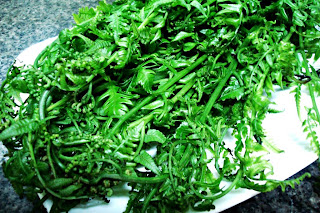Most of the time when it comes to making salad or ordering salad, we are not very interested as to where it came from. Most of us think that it is just pieces of leaves tossed in your choice of vinaigrette or dressing. All we are concerned about is that:
But really... these salads have an origin. Just look at the way of preparation as well as the ingredients feautured in that salad- you will know! From Waldorf Salad of England to the Caesar Salad of Mexico* down to the Raita of India and the Greek salad of... obviously, Greece!
But wait... how about our very own Philippine Salad? Is there even a Filipino Salad?
Of course there is!! And since it is Independence day today, I want to focus deeper on two of our very own Filipino salads. One made from Pako (Fiddlehead Fern) and one made from Arosep or Lato (Seaweed).
But wait! with the same procedure listed above you can make another variation! Instead of putting pako (fern), you can now put arosep/lato (seaweed)... then add chopped green mangoes!! This you can also serve with steamed rice and fried fish! Coupled with tortang talong or just grilled or boiled eggplant.
Craving to make one? Then visit your local marketplace. My dad usually buys the fiddlehead fern in Quezon City Circle or our local marketplace here in Batasan Hills. The arosep/lato (seaweed) he buys in the same market too. I actually had my first taste of this seaweed salad in Pangasinan back when I was ten or eleven... I didn't want to taste it before because it had onions and tomatoes (things that a kid normally doesn't want to eat). But after trying it out with fried tilapia, I am hooked!! Go ahead, make this easy Filipino recipe at home.
... and by the way... HAPPY INDEPENDENCE DAY!
- it is healthy (depends on how much dressing you put into it and the ingredients of that dressing... if it is full of mayonnaise then it's not as healthy as you think, my dear!)
- it cools us down (especially during a hot summer day where it is very nice to eat fresh salad cooled down in the fridge)
- it tastes divine (depending on your taste preference- the combination of ingredients and its special dressing/vinaigrette).
But wait... how about our very own Philippine Salad? Is there even a Filipino Salad?
Of course there is!! And since it is Independence day today, I want to focus deeper on two of our very own Filipino salads. One made from Pako (Fiddlehead Fern) and one made from Arosep or Lato (Seaweed).
Familiar with this plant? This is what pako or fern looks like. But what we eat is not these big leaves...
| Photo from Google. |
We eat the tiny shoots!
 |
| Pako (Fern). Photo from Google Images. |
It is normally blanched first for different reasons. To sanitize, improve its color, make it more tender but still crispy and lessen the bitter taste. Then we mix it with calamansi juice or vinegar, deseeded and diced tomatoes, julienne white or red onion, salted egg wedges (one is enough) or a touch of salt or bagoong (fish paste) if you're not a big fan of salted eggs. And hoila!! a mouth-watering salad perfect with a cup of steaming rice and fried fish!! yuuuumm... I'm drooling now...
But wait! with the same procedure listed above you can make another variation! Instead of putting pako (fern), you can now put arosep/lato (seaweed)... then add chopped green mangoes!! This you can also serve with steamed rice and fried fish! Coupled with tortang talong or just grilled or boiled eggplant.
| Arosep or Lato (Seaweed). Photo from Wikipedia. |
Craving to make one? Then visit your local marketplace. My dad usually buys the fiddlehead fern in Quezon City Circle or our local marketplace here in Batasan Hills. The arosep/lato (seaweed) he buys in the same market too. I actually had my first taste of this seaweed salad in Pangasinan back when I was ten or eleven... I didn't want to taste it before because it had onions and tomatoes (things that a kid normally doesn't want to eat). But after trying it out with fried tilapia, I am hooked!! Go ahead, make this easy Filipino recipe at home.
... and by the way... HAPPY INDEPENDENCE DAY!
 |
| My very own Pako salad made at home. |
* Contrary to the popular belief that Caesar salad originated from the United States, the recipe actually was invented by Caesar Cardini- an Italian owner of a restaurant in Tijuana Mexico.

Comments
Post a Comment